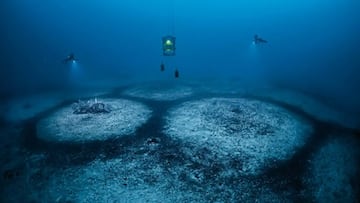Scientists stumble upon disturbing perfect circles on the seafloor and find the key: “It was alive”.
A team of marine researchers discovers over 1,300 underwater rings in the Mediterranean and solves the mystery after years of study.

In 2011, a team of scientists led by marine biologist Christine Pergent-Martini discovered perfectly symmetrical circular structures in the Mediterranean, near the coast of Corsica, that seemed to defy any logical explanation. More than 1,300 rings, about 20 meters in diameter with a dark spot at their center, were detected through satellite images and confirmed through underwater explorations.
The discovery sparked all kinds of hypotheses within the scientific community and the public. While some experts speculated that they were unusual geological formations, there were also more extravagant theories pointing to human or even extraterrestrial interventions. However, after over a decade of research, the scientists have uncovered the key to their origin.
The detailed study of these circles revealed that they were not geological formations, but biological structures known as coral atolls. These formations, composed of calcareous algae and various marine organisms, create rigid structures on the seafloor that, over time, form a circular arrangement. It was photographer and biologist Laurent Ballesta who submerged himself to reach one of the rings and realized that “it was alive.”
According to the researchers, the perfect symmetry of the rings is due to the radial growth of the algae and corals that make up the ecosystem. The interaction between the ocean currents and the development of the living organisms generates this unusual arrangement on the ocean floor.
“It is a habitat of great ecological value,” explained Pergent-Martini in statements collected by National Geographic. These structures house a rich biodiversity, including species like the yellow coral (Dendrophyllia cornigera), which is uncommon in the Mediterranean and typically found in deeper areas.
Implications for marine conservation
The discovery of coral atolls has important implications for the study and conservation of marine ecosystems. These formations play a crucial role in the biodiversity of the Mediterranean, providing shelter for numerous species and acting as indicators of the health of the oceans.
However, experts warn that these structures are extremely fragile and that climate change, along with pollution and human activity, could affect their development and conservation. Ocean acidification and rising temperatures may alter the growth of the organisms that form these atolls, threatening their existence.
Related stories
“It is essential to protect these habitats and understand better how they function,” said Pergent-Martini. “We still know very little about the ecological dynamics of these structures, but what is clear is that their preservation is key to maintaining the balance of marine ecosystems in the region.”
The discovery of the coral atolls demonstrates that the oceans still harbor fascinating secrets waiting to be uncovered. Exploring the seafloor remains one of the most unknown frontiers in science, and this discovery may be just the beginning of new revelations about life in the depths.

Complete your personal details to comment